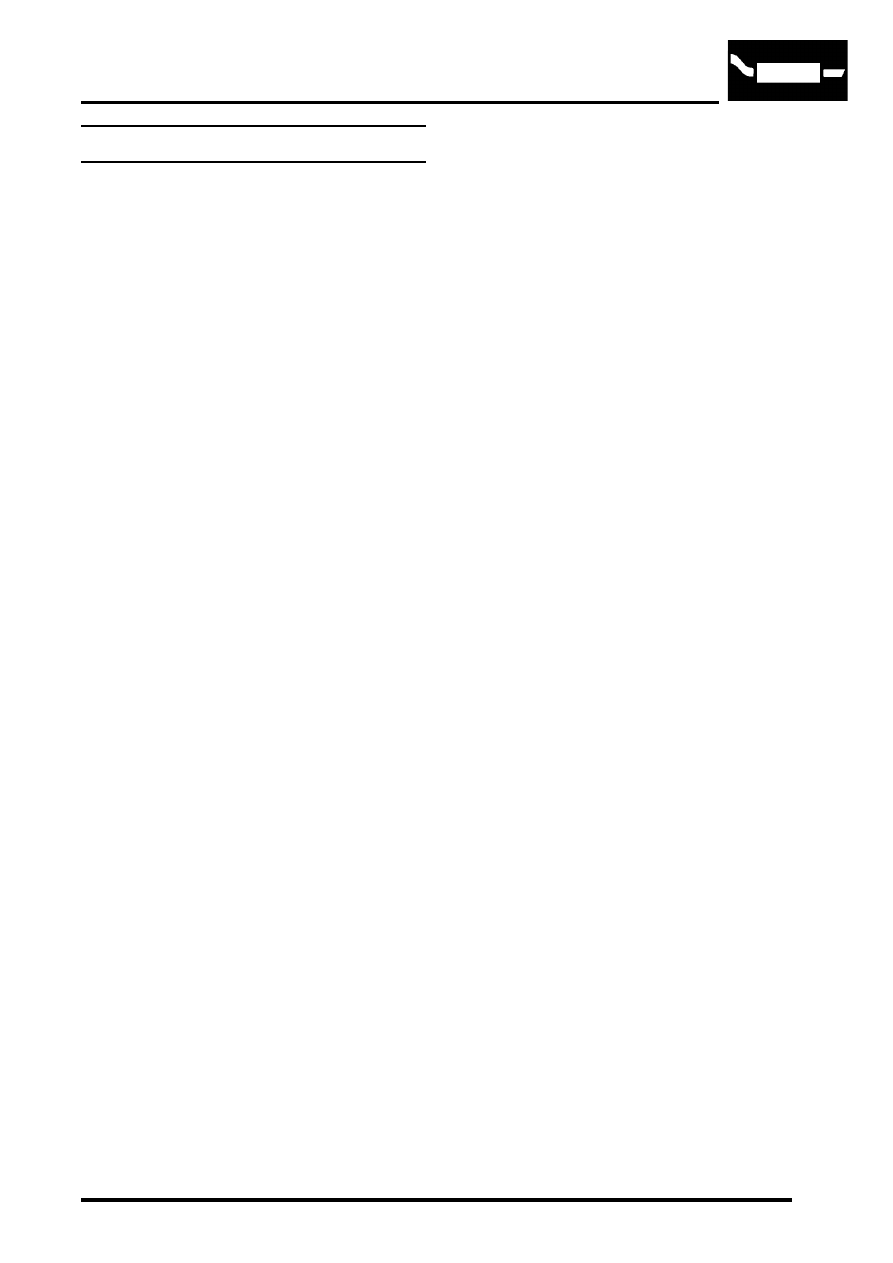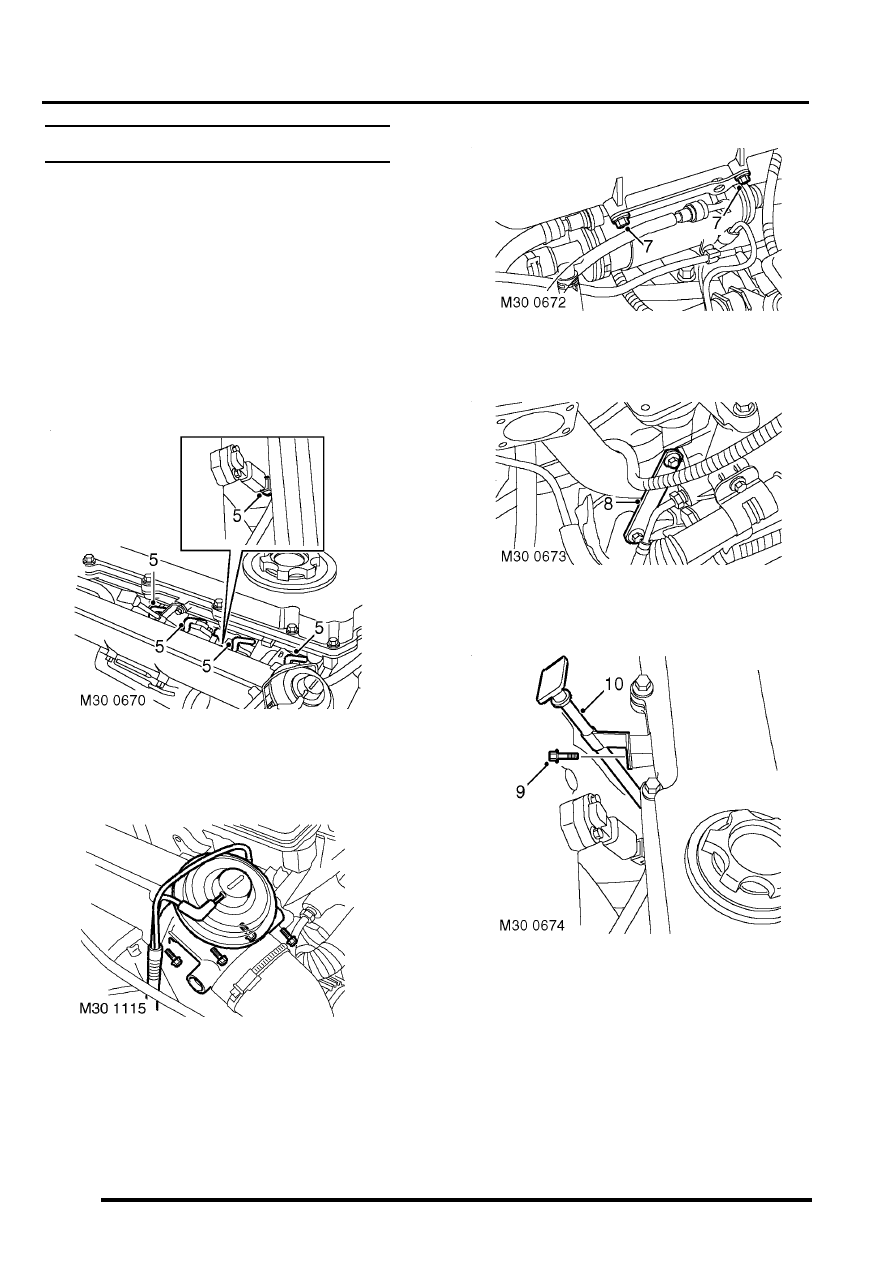Discovery 2. Manual — part 522

MANIFOLDS AND EXHAUST SYSTEMS - TD5
DESCRIPTION AND OPERATION
30-1-3
Description
General
The diesel engine has the inlet manifold attached to the right hand side of the engine and the exhaust manifold
attached to the left hand side of the engine. The inlet manifold directs cooled compressed air from the turbocharger
and intercooler into the cylinders, where it is mixed with fuel from the injectors. Exhaust gases from the exhaust
manifold can also be directed into the inlet manifold via a pipe from the exhaust manifold and an Exhaust Gas
Recirculation (EGR) valve on the inlet manifold. The exhaust manifold allows combustion gases from the cylinders to
leave the engine where they are directed into the exhaust system and turbocharger.
The exhaust system is attached to the turbocharger and is directed along the underside of the vehicle to emit exhaust
gases from a tail pipe at the rear of the vehicle. A silencer is installed midway along the system and a second tail
silencer is located at the rear of the vehicle.
Inlet manifold
The inlet manifold is a one piece aluminium casting. The manifold is secured to the cylinder head with two studs and
flanged nuts and eight flanged bolts. A one piece laminated gasket seals the manifold to the cylinder head.
Four threaded bosses on the manifold provide for the attachment of the fuel cooler. The fuel cooler is secured to the
manifold with four bolts. A boss with two threaded holes allows for the attachment of the combined intake air
temperature/pressure sensor. The sensor is secured to the manifold with two screws and sealed with a gasket.
At the forward end of the manifold, a machined face and four threaded holes provide for the attachment of the EGR
valve. The valve is sealed to the manifold with a gasket.
EMISSION CONTROL - Td5, DESCRIPTION AND OPERATION, Emission Control Systems.
Exhaust manifold
The exhaust manifold is made from cast iron. The manifold has five ports, one from each cylinder, which merge into
one flanged outlet connection positioned centrally on the manifold.
The manifold is attached to the cylinder head with ten studs and flanged nuts. A laminated metal gasket seals the
manifold to the cylinder head. The flanged outlet on the manifold provides the attachment for the turbocharger, which
is attached with three studs and flanged nuts and sealed with a metal laminated gasket.
A second flanged outlet, located at the forward end of the manifold, provides attachment for the EGR pipe. The EGR
pipe is secured to the manifold with two cap screws and connected to the EGR valve mounted on the inlet manifold.
There is no gasket used between the pipe and the exhaust manifold.
EMISSION CONTROL - Td5, DESCRIPTION AND OPERATION, Emission Control Systems.
Exhaust system
The exhaust system comprises a front pipe, an intermediate pipe which incorporates a silencer and a tail pipe
assembly which also has a silencer. The exhaust system is constructed mainly of 63 mm (2.48 in) diameter extruded
pipe with a 1.5 mm (0.06 in) wall thickness. All pipes are aluminized to resist corrosion and the silencers are fabricated
from stainless steel sheet.
MANIFOLDS AND EXHAUST SYSTEMS - TD5
30-1-4
DESCRIPTION AND OPERATION
Front pipe assembly
The front pipe is of welded and fabricated tubular construction. The front pipe is connected to a flange on the
turbocharger and secured with three flanged nuts and sealed with a metal laminated gasket. The front pipe
incorporates a flexible pipe near the connection with the turbocharger and terminates in a flanged connection with the
intermediate pipe.
The flexible pipe is formed into a concertina shape with woven metal strands around its outer diameter. The flexible
pipe allows for ease of exhaust system alignment and also absorbs engine vibration. The woven metal strands also
increase the longevity of the flexible pipe.
The front pipe is attached via a bracket and a mounting rubber to the chassis. The mounting rubber allows ease of
alignment and vibration absorption.
Intermediate pipe and silencer
The intermediate pipe is of welded and fabricated tubular construction. It connects at its forward end to the front pipe
flange. Two captive studs on the intermediate pipe flange allow for attachment to the front pipe with locknuts. The rear
section of intermediate pipe connects to the tail pipe assembly via a flanged joint, sealed with a metal gasket and
secured with locknuts and studs.
The forward and rear sections are joined by a silencer. The silencer is fabricated from stainless steel sheet to form
the body of the silencer. An end plate closes each end of the silencer and is attached to the body with seam joints.
Perforated baffle tubes, inside the silencer, are connected to the inlet and outlet pipes on each end plate. Internal
baffle plates support the baffle tubes and, together with a stainless steel fibre packing, absorb combustion noise as
the exhaust gases pass through the silencer.
The intermediate pipe is attached by two brackets, positioned at each end of the silencer, and two mounting rubbers
to the chassis. The mounting rubber allows for ease of alignment and vibration absorption.
Tail pipe assembly
The tail pipe is of welded and fabricated construction. The tail pipe connects to the intermediate pipe with a flanged
joint secured with locknuts and sealed with a metal gasket. The pipe is shaped to locate above the rear axle allowing
clearance for axle articulation. The pipe is also curved to clear the left hand side of the fuel tank which has a reflective
shield to protect the tank from heat generated from the pipe.
A fabricated silencer is located at the rear of the tail pipe. The silencer is circular in section and is constructed from
stainless steel sheet. A baffle tube is located inside the silencer and the space around the baffle tube is packed with
a stainless steel fibre. The holes in the baffle tube allow the packing to further reduce combustion noise from the
engine. The tail pipe from the silencer is curved downwards at the rear of the vehicle and directs exhaust gases
towards the ground. The curved pipe allows the exhaust gases to be dissipated by the airflow under the vehicle and
prevents the gases from being drawn behind the vehicle.
The tail pipe is attached by a bracket, positioned forward of the silencer, and a mounting rubber to the chassis. The
mounting rubber allows ease of alignment and vibration absorption.

MANIFOLDS AND EXHAUST SYSTEMS - TD5
REPAIRS
30-1-5
REPAIRS
Pipe - front
$% 30.10.09
Remove
1. Remove 3 nuts, release front pipe from
turbocharger and discard gasket.
2. Raise vehicle on ramp.
3. Remove 2 nuts and release front pipe from
intermediate pipe/silencer.
4. Remove 16 bolts and remove chassis cross
members.
5. Release and remove front pipe from mounting.
Refit
1. Clean front pipe and mating faces.
2. Position front pipe and new front pipe to
turbocharger gasket. Align front pipe to
intermediate pipe/silencer and turbocharger.
3. Connect mounting to front pipe.
4. Fit nuts securing front pipe to turbocharger and
intermediate pipe/silencer and tighten to 27 Nm
(20 lbf.ft) .
5. Fit chassis cross members and tighten bolts to
25 Nm (18 lbf. ft).

MANIFOLDS AND EXHAUST SYSTEMS - TD5
30-1-6
REPAIRS
Gasket - inlet manifold
$% 30.15.08
Remove
Note: The following procedure covers engines
fitted with or without an EGR cooler. The EGR
cooler is bolted to the front of the cylinder head.
1. Remove battery cover.
2. Disconnect battery earth lead.
3. Remove 3 bolts and remove engine acoustic
cover.
4. Release retainers and remove upper fan cowl.
5. Disconnect leads from 4 glow plugs and
multiplug from MAP sensor.
6. Remove 4 bolts, release EGR valve from inlet
manifold and discard gasket.
7. Remove 4 bolts securing fuel cooler to inlet
manifold.
8. Remove 2 bolts and remove alternator support
bracket.
9. Remove bolt securing engine dip stick tube to
camshaft carrier.
10. Remove dip stick tube and discard 'O' ring.

Нет комментариевНе стесняйтесь поделиться с нами вашим ценным мнением.
Текст